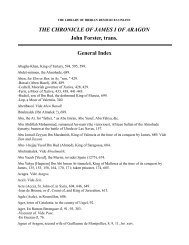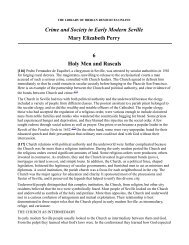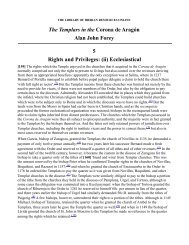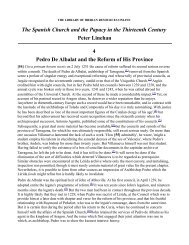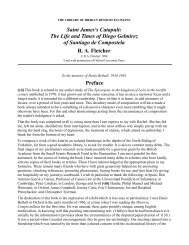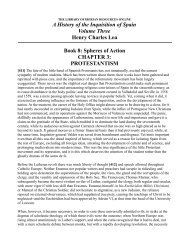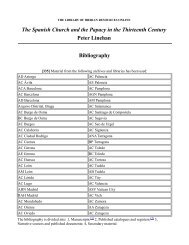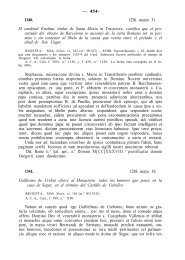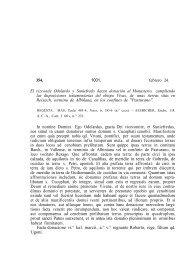Chapter 12 - The Library of Iberian Resources Online
Chapter 12 - The Library of Iberian Resources Online
Chapter 12 - The Library of Iberian Resources Online
You also want an ePaper? Increase the reach of your titles
YUMPU automatically turns print PDFs into web optimized ePapers that Google loves.
THE LIBRARY OF IBERIAN RESOURCES ONLINE<br />
Irrigation and Society in Medieval Valencia<br />
Thomas F. Glick<br />
<strong>Chapter</strong> Twelve<br />
<strong>The</strong> Impact <strong>of</strong> Islam upon the Terminology <strong>of</strong> Irrigation<br />
[217] <strong>The</strong> lexicon <strong>of</strong> irrigation in eastern Spain is characterized by two general features: semantic<br />
fluidity and regional variation. Definitions are <strong>of</strong>ten not strict and meanings frequently are vague. One<br />
word can apply to differing phenomena and, conversely, a single thing can be described by a variety <strong>of</strong><br />
words. (1) Regional variation is a logical corollary to semantic fluidity: words vary in meaning from<br />
place to place. But within each locale irrigation terms are both semantically and chronologically stable.<br />
Students <strong>of</strong> Spanish and Islamic irrigation terms alike have remarked the multiplicity <strong>of</strong> words<br />
describing canals. "<strong>The</strong> medieval texts <strong>of</strong> Spain abound in words and expressions relating to water<br />
carriers," wrote the philologist Eero Neuvonen. "It is <strong>of</strong>ten very difficult to establish a significant<br />
difference between one word and another." (2) In the texts studied by Neuvonen words such as canal,<br />
calze, acueducto, and conducto de agua are used alternately with each other indiscriminately. In like<br />
manner Etore Rossi reported that "in the region <strong>of</strong> Raimah (Yemen), water-courses are indicated with<br />
many synonyms: gail, nahr, 'ain al-mâ'." (3)<br />
Medieval Valencian canal terminology was the poet's delight, as seen in Jaume Roig's description <strong>of</strong> the<br />
water flowing "per rius, braçals, conduyts, canals e çequioles, rolls e filloles." (4) Roig's catalog <strong>of</strong><br />
canals is a mixture <strong>of</strong> literary terms <strong>of</strong> a general nature (for example, conduyt, conduit) and the specific<br />
terms <strong>of</strong> everyday irrigation practice in the Valencian huerta. <strong>The</strong> braçal was a major branch canal,<br />
second in size to the "mother canal" (cequia mare) from which it was derived. Next in size and order<br />
[218] was the fila, then the fillola, and finally the cequiola, usually a small ditch within the bounds <strong>of</strong><br />
an individual field and the property <strong>of</strong> its owner. <strong>The</strong> roll, an opening or conduit diverting water from<br />
the man canal into a secondary channel, is analogous to the boquera, or field turn-out, the opening or<br />
gate through which the cultivator diverts water from the irrigation system onto his own field.<br />
<strong>The</strong> same or related terms may have different values in different places. In Gandia the hilo (the<br />
etymological equivalent <strong>of</strong> the Valencian fila, as mentioned above) is the functional equivalent <strong>of</strong> the<br />
Valencian braçal. One sizable channel (serving numerous irrigators) in medieval Castellón was called<br />
<strong>The</strong> Cequiol, hardly the equivalent <strong>of</strong> the insignificant cequiola <strong>of</strong> Valencia. <strong>The</strong> hijuela (etymological<br />
equivalent <strong>of</strong> fillola) <strong>of</strong> Onhuela is the same as the hila in the system <strong>of</strong> Alfeitami and the regadera <strong>of</strong><br />
Murcia; (5) yet, all three systems draw water from the Segura River and are regulated by similar<br />
institutions.<br />
<strong>The</strong> Segura vega is extraordinarily rich in irrigation vocabulary, particularly in terms for channels,<br />
owing to the double system <strong>of</strong> delivery and drainage canals. <strong>The</strong> former system (that <strong>of</strong> aguas vivas) is<br />
arranged from largest to smallest: acequia madre (or mayor), then acequia menor (or arroba), then<br />
brazal, and finally hijuela or regadera. <strong>The</strong> drainage (aguas muertas) hierarchy runs from azarbe (or<br />
landrona or merancho), the largest channel, to its diminutive, azarbeta, to escorredor, the smallest. (6)<br />
Thus the meaning <strong>of</strong> the terms is rarely generic, but depends upon the configuration <strong>of</strong> the particular
system, the size <strong>of</strong> the canal and its place in the hierarchical network from main canal down to field,<br />
and the function <strong>of</strong> the system, whether for delivery or drainage. (7)<br />
A similar pattern is evident in the words used to describe hydraulic wheels. Strictly speaking, a noria is<br />
a wheel moved by the force <strong>of</strong> the current alone, while a sinia is one moved by human or animal<br />
power: but only in Murcian usage is this distinction correctly made. In Catalonia and Valencia sinia<br />
displaced noria completely and was used to describe all hydraulic [219] wheels. In other parts <strong>of</strong> Spain<br />
the common word for diversion dam, azud (and its variant azuda), came to be applied to the current<br />
wheel. (8)<br />
At the base <strong>of</strong> this fluidity is regional variation in irrigation customs along ethnic lines. Terminology<br />
varied principally as the ethnic composition <strong>of</strong> the original Muslim irrigators and the Christian settlers<br />
varied. <strong>The</strong> place <strong>of</strong> arabisms in the picture is crucial. <strong>The</strong> fact that there were not enough terms in the<br />
Romance tongues <strong>of</strong> the conquerors to replace the multiplicity <strong>of</strong> definitions in a highly developed<br />
irrigation system made this sector <strong>of</strong> the lexicon particularly susceptible to linguistic borrowing; the<br />
fact that Arabic was unintelligible to most <strong>of</strong> the new settlers ensured that the borrowing would be<br />
loosely structured. Thus many areas <strong>of</strong> human thought and industry were described by two sets <strong>of</strong><br />
terms. <strong>The</strong> Romance tongue <strong>of</strong> the Christians, together with Latin expressions <strong>of</strong> long acceptance in<br />
Catalonia and Castile, coexisted with words acquired from the Arabs. Irrigation was one <strong>of</strong> those areas<br />
<strong>of</strong> culture (warfare was another) where the arabisms tended to predominate.<br />
That many <strong>of</strong> the concepts <strong>of</strong> irrigation were new to the Christians is indicated by the intrusion <strong>of</strong><br />
vernacular arabisms into Latin documents in the thirteenth and early fourteenth centuries. This<br />
phenomenon is indicative <strong>of</strong> the lack <strong>of</strong> consensus concerning a given term (evidence <strong>of</strong> entrenched<br />
regional variation, in other words), and the lack <strong>of</strong> a Latin or Romance tradition to guide the scribe. (9)<br />
REGIONAL AND LOCAL VARIATION<br />
Most <strong>of</strong> the arabisms common throughout eastern Spain were present either in Castilian or Catalan by<br />
the thirteenth century. Sinia and safareig, both specialized hydraulic devices, were among the earliest<br />
peninsular arabisms, dating from the epoch <strong>of</strong> Islamic expansion (711 to the mid-eleventh century).<br />
Cequia and açut, the most common and typical <strong>of</strong> Valencian irrigation arabisms, date from the epoch <strong>of</strong><br />
the great Christian conquests (mid-[220]eleventh to the end <strong>of</strong> the twelfth century) and were therefore<br />
already in the language when the Valencian region was taken from the Muslims. Alcaduf, aljub,<br />
azumbre, çabacequies, and marjal are arabisms which passed into the Romance vernaculars in the<br />
course <strong>of</strong> the thirteenth century. (10) Most <strong>of</strong> the localized arabisms as well must have passed into the<br />
Christian vernacular in the late thirteenth century during the post-Conquest process <strong>of</strong> learning local<br />
customs from Muslim irrigators.<br />
<strong>The</strong> lists that follow include all the important regional arabisms and most <strong>of</strong> the significant local ones;<br />
the contents <strong>of</strong> the lists are summarized in Tables 22 and 23.<br />
Regional Irrigation Arabisms<br />
1) açut (çut, azut), "diversion dam," Arabic al-sudd; the most common and widest spread arabism<br />
besides cequia. <strong>The</strong> Romance equivalent, resclosa, retains the sense <strong>of</strong> the original Arabic sadda, to<br />
close. <strong>The</strong> word has been used consistently throughout eastern Spain from the Reconquest to the<br />
present, and the Castilian form, azud, dates from the period <strong>of</strong> the great Christian conquests (1050 to<br />
the end <strong>of</strong> the twelfth century). Both the word sudd and the technology are typical <strong>of</strong> southern Arabia.<br />
(11)
2) albellon, "sewer, drain," Arabic al-bâlû'a. Usually an urban term in medieval Valencian documents,<br />
typically associated with vall, "sewer, moat." In Murcia, however, its oldest meaning was that <strong>of</strong> a<br />
permanent opening in a channel, and other references corroborate its association with irrigation. (<strong>12</strong>)<br />
3) alcaduf, "bucket <strong>of</strong> a water wheel," Arabic al-qâdûs: a very common term in Islamic irrigation,<br />
originally referring to the buckets <strong>of</strong> the Persian water wheel, by extension a measure <strong>of</strong> water and even<br />
(in Spain) a conduit. <strong>The</strong> qâdûs is the common instrument for measuring water in the Saharan oases.<br />
(13)<br />
4) aljup (aljub), "cistern," Arabic al-jubb. (14)<br />
5) almenara, "return ditch," Arabic al-manâhir, pl. <strong>of</strong> manhar, "canal." (15) [221]<br />
6) çabacequies (çabacequia and, through influence <strong>of</strong> cequier, çabacequier), "master <strong>of</strong> the canals" (an<br />
irrigation <strong>of</strong>ficial), Arabic sâhib al-sâqiya. (16)<br />
7) cequia, "irrigation canal," Arabic sâqiya; the most characteristic and widespread irrigation arabism.<br />
In thirteenthcentury Castilian documents (Castilian acequia) it frequently has the meaning <strong>of</strong> a canal<br />
that supplies a mill, but in Valencia it means any kind <strong>of</strong> irrigation canal. (17) Sâqiya is the common<br />
word for irrigation canal throughout the Islamic world.<br />
8) marjal (almarjal, almargal), "swamp," Arabic marj, "meadow." In Valencian documents it has no<br />
synonyms. (18)<br />
9) noria, "hydraulic wheel," Arabic nâ'ûra (from na'ara, to grunt); one <strong>of</strong> the earliest hydraulic arabisms<br />
in Spanish. <strong>The</strong> addition <strong>of</strong> the i to the primitive form nora, annora, is possibly explained by the<br />
influence <strong>of</strong> acenia (sinia) and acequia. <strong>The</strong> first document is <strong>of</strong> the twelfth century. (19)<br />
l0) safareig, "cistern," Arabic sahrîj. (20)<br />
11) sinia (Medieval Valencian cenia), "Persian wheel," Arabic sâniya; Castilian-Murcian acenia, aceña.<br />
In the Catalan zone sinia is understood as synonymous with noria, also an arabism. But strictly<br />
speaking a sâniya is driven by animal power, while the nâ'ûra is moved by force <strong>of</strong> water alone. One <strong>of</strong><br />
the earliest <strong>of</strong> irrigation arabisms, first documented in 945. (21)<br />
<strong>12</strong>) tanda, "irrigation turn." Corominas suggests that an Arabic derivation from *tanzîm (the root means<br />
to put in order) is preferable to one from the Latin tanta. <strong>The</strong> first appearance is in thirteenth-century<br />
Catalonia as the standard word for "irrigation turn," although in Valencia and Murcia some local<br />
variants (all arabisms) occur. (22)<br />
13) tarquim, "silt." Corominas suggests a derivation from the Arabic *tarkîm, from the root meaning<br />
"to pile up." (23)<br />
Localized Arabisms: Valencia, Murcia, Lorca<br />
1) açarb, "drainage canal" (Murcia), Arabic al-zarb. (24)<br />
2) ador, "turn" (Gandia), Arabic al-daur. A feminine form [222] <strong>of</strong> daur is a common word for "turn" in<br />
modern Yemen. (25)<br />
3) albala, "water-ticket" (Alicante), Arabic al-barâ'a. <strong>The</strong> albala is a ticket representing a certain<br />
number <strong>of</strong> minutes <strong>of</strong> water on sale at the water auction at Alicante. (26)<br />
4) almahacen, "water that remains unapportioned, for communal use" (Lorca), Arabic al-mahzan
(storehouse, deposit). (27)<br />
5) almatzem, "divisor" (Gandia), Arabic al-miqsam. Not a common term in Spain but <strong>of</strong> wide diffusion<br />
in Islam, as far east as Persia. (28)<br />
6) azumbre, a water measure (Novelda, Elche), Arabic al-thumn, "one-eighth." (29)<br />
7) dula, "turn" (Gandia, Elche); also a water measure synonymous with hila (Alicante), Arabic daula.<br />
Another term found both in the Yemen and the Sahara. (30)<br />
8) jarique, noun, or verb jaricar, "to unite various hilas <strong>of</strong> water" bought at auction in order to irrigate<br />
with a greater body <strong>of</strong> water and to transport it over a long distance with minimal loss (Lorca); Arabic<br />
sharîk, "a partner." An important reminiscence <strong>of</strong> communal irrigation practices among Muslim<br />
irrigators. (31)<br />
9) jarro, a water measure (Lorca, Jumilla), Arabic jarra, "jug." In Lorca and Jumilla the jarro is equal<br />
to one-half hour <strong>of</strong> water. It takes its name from the clepsydra (water clock), a vessel with a hole in the<br />
bottom which was the standard time measure for irrigation in the North African oases and in southern<br />
Spain. <strong>The</strong> word is frequently found in thirteenth-century Romance texts, indicating its adoption after<br />
the conquest <strong>of</strong> Lorca and the Murcian region. (32)<br />
10) martava, "turn" (Alicante, Novelda), Arabic martaba. (33)<br />
11) merancho, "drainage ditch" (Murcia), Arabic marj. (34) <strong>The</strong> connection between drainage and<br />
marjals is clear. Drainage <strong>of</strong> marshland was an operation described largely in arabisms.<br />
<strong>12</strong>) rafa, "canal check" (Murcia), Arabic raf', "raising up." (35) An interesting example <strong>of</strong> an arabism<br />
that describes a function different from that expressed by its common [223] Romance synonym,<br />
parada. <strong>The</strong> canal check (<strong>of</strong>ten simply a board placed across a canal) serves both to stop the flow (the<br />
meaning <strong>of</strong> parada, from panarse, to stop) in order to divert water and to raise the level (the meaning<br />
<strong>of</strong> rafa).<br />
13) sistar, "divisor" (Vall de Segó). Corominas has suggested a derivation from the Latin sistere (to<br />
stop); (36) but this must be questioned because irrigation terms are usually precise as to function, and a<br />
sistar divides water (its more usual synonym is partidor) rather than stopping it. Since the Vall de Segó<br />
had a substantial Muslim population, it seems proper to seek a derivation from the Arabic root sh-t-r,<br />
"to divide into two equal parts."<br />
14) tahulla, a measure <strong>of</strong> land (Murcia) but also a measure <strong>of</strong> water equivalent to one hour (Lorca),<br />
Arabic tahwila, "field." (37)<br />
<strong>The</strong> foregoing data permit several generalizations concerning the frequency and function <strong>of</strong> arabisms in<br />
the technical vocabulary <strong>of</strong> medieval irrigation: 1) <strong>The</strong> Arabic word and the arabism usually have the<br />
same meaning. (38) Agricultural terms especially are conservative by nature and tend to retain the<br />
original meaning so long as the use <strong>of</strong> the object is the same. 2) Romance synonyms are likely to be<br />
literal translations <strong>of</strong> the original Arabic meaning: thus resclosa is the equivalent <strong>of</strong> açut, from sadda,<br />
"to close"; partidor is the synonym <strong>of</strong> almatzem, from qasama, "to divide." 3) When all the synonyms<br />
describing a single phenomenon are arabisms, there is a strong presumption that the concept or<br />
technique was unknown or undeveloped outside <strong>of</strong> the Islamic orbit or, at any rate, was very intimately<br />
associated with the Islamic style <strong>of</strong> irrigating: for example, the words for turn (dula, ador, martava), for<br />
return ditch (almenara, azarbe, merancho), for cistern (safareig, aljup), and for water wheel (sinia,<br />
noria).
Arabism Meaning Major<br />
variants<br />
açut diversion<br />
dam<br />
albellon sewer,<br />
drain<br />
alcaduf bucket <strong>of</strong><br />
a noria<br />
Table 22<br />
Regional irrigation arabisms<br />
Medieval<br />
synonyms<br />
Medieval Toponyms Romance Arabism Arabic Meaning Root<br />
Castilian<br />
çut, azut azud, açuda Burjassot<br />
(Valencia)<br />
- albollon El Albellon<br />
(Elche)<br />
- alcaduz,<br />
arcaduz<br />
Calduf<br />
(Gandia)<br />
aljup cistern aljub algibe Aljupet<br />
(Elche), Port<br />
d'Aljup<br />
(Murcia)<br />
almenara return<br />
ditch<br />
çabacequie<br />
s<br />
an<br />
<strong>of</strong>ficial,<br />
literally<br />
"master<br />
<strong>of</strong> the<br />
canals"<br />
cequia irrigation<br />
canal<br />
reclosa,<br />
presa<br />
- as-sudd dam to close<br />
vall - al-bâlû'a sewer, drain -<br />
fortera jarro al-qâds waterbucket<br />
, scoop<br />
-<br />
- safareig al-jubb cistern -<br />
- - - - - almanâhir<br />
çabacequia<br />
,<br />
çabacequie<br />
r<br />
marjal swamp almarjal,<br />
almargal<br />
noria hydraulic<br />
wheel<br />
sobrecequier<br />
o<br />
- acequia Guadassequies<br />
(river)<br />
- sobrecequie<br />
r<br />
ayguaduyt,<br />
fila<br />
- sâhib alsâqiya<br />
arroba sâqiya irrigation<br />
canal<br />
canals to flow,<br />
gush<br />
master <strong>of</strong> -<br />
the canal<br />
- - - - marj meadow -<br />
- annora La Nora<br />
(Murcia)<br />
safareig cistern - xafariz,<br />
zafariche<br />
sinia hydraulic<br />
wheel<br />
Zarahiche<br />
(Murcia)<br />
cenia aceña Cenia (river),<br />
Aceña, Aceñas<br />
(many), Azana<br />
(Toledo), etc.<br />
to<br />
irrigate<br />
- cenia nâ'ûra hydraulic<br />
wheel<br />
to grunt<br />
- aljup sahrîj cistern -<br />
- noria sâniya Persian<br />
wheel<br />
tanda turn - tanda - - ador, *tanzîm order to put<br />
dula,<br />
martava<br />
in order<br />
tarquim silt - tarquin Tarquin<br />
(Murcia)<br />
Table 23<br />
Localized irrigation arabisms<br />
Arabism Meaning Place Common<br />
synonym<br />
açarb,<br />
azarbe<br />
drainage canal Murcia landrona,<br />
merancho<br />
fanch - *tarkîm piling up to pile<br />
up<br />
Arabic Meaning<br />
az-zarb canal, drain<br />
ador turn Gandia tanda, dula ad-daur rotation, turn<br />
albala water ticket Alicante - al-barâ'a license<br />
-
almahacen undivided water for<br />
common use<br />
Lorca - al-mahzan storehouse, deposit<br />
almatzem divisor Gandia partidor al-miqsâm divider<br />
azumbre water unit Novelda - thumn 1/8<br />
dula turn, water unit Gandia, Elche,<br />
Alicante<br />
tanda, hila daula, turn, rotation,<br />
alternation<br />
jarique sharer <strong>of</strong> water Lorca - sharîk partner<br />
jarro water measurement<br />
unit<br />
martava turn Alicante,<br />
Novelda<br />
Lorca - jarra cup, jar<br />
tanda, dula martaba rank; arrangement in<br />
regular sequence<br />
merancho drainage ditch Murcia azarbe marj meadow<br />
rafa canal check Murcia parada raf' raising up<br />
sistar divisor Vall de Segó partidor shatr, shitra<br />
(?)<br />
tahulla measure <strong>of</strong> land Murcia jovada,<br />
fanega<br />
water measurement<br />
unit<br />
Partition; division in 2<br />
equal parts<br />
tahwila field piece <strong>of</strong> land<br />
Lorca caballeria tahwila field piece <strong>of</strong> land<br />
If these generalizations are applied to words <strong>of</strong> presumed but unproven Arabic etymology, it is possible<br />
to make some guesses merely on the basis <strong>of</strong> whether the concept was developed outside [226] the<br />
Islamic framework. Thus tanda, in spite <strong>of</strong> phonetic difficulties in Corominas' derivation, is probably an<br />
arabism. (39) Tanda and tanta do not mean the same thing; tanzim comes much closer. (40) <strong>The</strong> fact that<br />
all <strong>of</strong> its synonyms (dula, ador, martava) are arabisms suggests that the concept <strong>of</strong> the turn was<br />
unknown or not highly developed among Christians. Likewise sistar from shatara, in spite <strong>of</strong> the<br />
infrequently found change from sh to s, is attractive because it means the same as partidor. Almatzem,<br />
the local variant for partidor in Gandia, provides a parallel case. (Vall de Segó and Gandia were among<br />
the relatively few irrigated areas in the medieval kingdom <strong>of</strong> Valencia where there were significant<br />
numbers <strong>of</strong> Muslim irrigators.)<br />
ARABIC THEMES IN ROMANCE VERNACULAR<br />
<strong>The</strong> expressions for the typical irrigation land-use patterns, huerta and vega, both seem to bear the<br />
Islamic imprint. It is probable that huerta is a translation <strong>of</strong> the Arabic, bustân, both words meaning<br />
"garden." (41) Vega is <strong>of</strong> uncertain origin, but Arnald Steiger believes it to be an arabism. (42)<br />
<strong>The</strong> irrigation system <strong>of</strong> Lorca preserves two interesting measures, casa de agua and tiempo de agua,<br />
both probably <strong>of</strong> Islamic ancestry. A royal privilege <strong>of</strong> September 23, <strong>12</strong>68, provides that the water <strong>of</strong><br />
Lorca is to be divided "communally, by days and by times" ("comunamente por dias y por tiempos").<br />
<strong>The</strong> concept <strong>of</strong> a "time" <strong>of</strong> water recalls the Arabic waqt, used in the same way (as a unit <strong>of</strong> water) in<br />
Iraq. (43) Also in Lorca, a casa (house) is said to be twelve hours <strong>of</strong> water, each day being divided into<br />
two "houses." If this expression is in fact medieval it seems quite clearly to be a translation <strong>of</strong> dâr,<br />
"house," which, in this case, is a dialectal pronunciation <strong>of</strong> daur, "turn." In the Saharan oasis <strong>of</strong> El
Outaïa a dâr is, similarly, twelve hours <strong>of</strong> water. (44)<br />
<strong>The</strong> term expressing the standard unit <strong>of</strong> water measure in most <strong>of</strong> the kingdom <strong>of</strong> Valencia -- the fila<br />
or hilo, "thread," <strong>of</strong> water -- has proven enigmatic to generations <strong>of</strong> scholars: they have neither<br />
understood the rationale <strong>of</strong> the measurement nor [227] have they explained what a "thread" has to do<br />
with water. <strong>The</strong> term "thread <strong>of</strong> water" was known in Andalusí Arabic. In a document <strong>of</strong> <strong>12</strong>23 (619 H.)<br />
describing a water dispute between two towns near Morvedre, the measurement unit is the khait, or<br />
thread. (45) <strong>The</strong> only other pre-modern source known to me that corroborates this usage is Pedro de<br />
Alcalá's translation <strong>of</strong> kait min mi (thread <strong>of</strong> water) as corriente venaje de agua (source-current <strong>of</strong><br />
water). (46) A modern Arabic-French dictionary published in Algiers, and thus reflecting Magribi usage,<br />
defines khait as "saignée a un canal d'irrigation, rigole d'arrosement" (47) that is, not a measure, but the<br />
ditch itself. This usage corresponds to an alternative use <strong>of</strong> fila in Valencia with the meaning <strong>of</strong> ditch or<br />
canal, synonymous with cequia but perhaps connoting a smaller channel.<br />
<strong>The</strong>re is another example <strong>of</strong> the same term expressing both a liquid measure and a channel. In<br />
thirteenth-century Murcia arrova, usually a liquid measure (<strong>of</strong> olive oil, for example) also had the sense<br />
<strong>of</strong> a channel. Alfonso X <strong>of</strong> Castile ordered the sobrecequiero <strong>of</strong> Orihuela to look to the cleaning <strong>of</strong> the<br />
cequias, filas, arnouas, and azarbes. (48)<br />
<strong>The</strong> medieval documentation, especially that <strong>of</strong> Castellón, provides numerous examples <strong>of</strong> important<br />
canals called filas: for example, "la fila dels dos hulls," the "files de la doberia" (that is, adobenia,<br />
tannery), and "les files de Na Orellana." (49) That the Arabic equivalent khait was used in the same way<br />
is clear from two toponyms previously misunderstood. In the town limits <strong>of</strong> Alberic there is a canal<br />
named Alfait with its origin in the same springs that give rise to the Riu dels Ulls. (50) Miguel Asín<br />
Palacios derived Alfait from al-faid, "stream," from the verb "to overflow," so called because the head<br />
is augmented in times when run-<strong>of</strong>f water infiltrates into it. (51) In view <strong>of</strong> the literalism displayed by<br />
medieval Spaniards -- Arabs and Christians alike -- in irrigation terminology, it is much simpler to<br />
derive Alfait from al-khait, "thread" (in the sense <strong>of</strong> fila, "ditch"). (52) Naming a canal "<strong>The</strong> Canal" was<br />
by no means uncommon in the Valencian region. (53) An analogous development is the name <strong>of</strong><br />
Faitanar, one <strong>of</strong> the main canals <strong>of</strong> the Valencian huerta; it is quite clearly [228] derivable from Arabic,<br />
khait al-nahr ("thread <strong>of</strong> the river" in the sense <strong>of</strong> a canal diverted from the river), in spite <strong>of</strong> contrived<br />
efforts to find a Romance derivation for it. (54)<br />
Several passages <strong>of</strong> the Repartimiento <strong>of</strong> Murcia allude to "irrigation <strong>of</strong> alfayt" (that is, "riego de<br />
çequia et dalffayat, se reguen dalfayt" (55) ). <strong>The</strong> editor, possibly following Asín in associating alfayt<br />
with al-faid, understands the term to be flood irrigation (crecida). (56) For reasons already indicated, a<br />
derivation from faid is much less likely than from khait; therefore "riego de equia et dalffayat" most<br />
likely means, simply, irrigation from a large channel and a smaller, secondary one.<br />
HYDRAULIC PLACE NAMES IN VALENCIA AND MURCIA<br />
Many <strong>of</strong> the arabisms discussed above also appear in place names. I shall not attempt to present a<br />
complete description <strong>of</strong> all toponyms having to do with irrigation; enumeration here is limited largely<br />
to arabisms as names <strong>of</strong> hydraulic appurtenances, such as canals and divisors, in order to give a graphic<br />
illustration <strong>of</strong> the Islamic imprint on irrigation.<br />
Of the main canals <strong>of</strong> the huerta <strong>of</strong> Valencia two, in addition to Faitanar, are named with arabisms<br />
bearing hydraulic allusions. <strong>The</strong> Favara Canal derives its name from al-fawwâra, "spring." Nicolau<br />
Primitiu, basing his argument on a single variant, Alfara (which he believes is a shortened form <strong>of</strong><br />
Alfafar) posits a Germanic derivation. (57)
This is highly dubious reasoning, and the Arabic etymology gains further support from the presence <strong>of</strong><br />
the form Favara in the Repartimiento and from the appearance <strong>of</strong> the primitive Arabic article Alfavara<br />
in a document <strong>of</strong> 1430. (58) Rascanya is also an arabism, from râs, "head," and canya (from canna,<br />
canal). Here, though, the canal takes its name from the place it irrigates, called Rascayna (cayna, the<br />
diminutive <strong>of</strong> canna) in the Repartimiento. (59)<br />
A repeated canal name in the Valencian region is Algirós (also spelled Aljiros, Algeros, Algiroz). It is<br />
the name <strong>of</strong> one <strong>of</strong> the three major branches <strong>of</strong> the Mestalla system in Valencia and <strong>of</strong> [229] an<br />
important canal near Alcira. Perhaps, too, the canal in Elche called Algorós is related etymologically.<br />
(60) <strong>The</strong> derivation is from al-zurûb, the plural <strong>of</strong> zarb (from zariba, to flow). But in spite <strong>of</strong> the plural<br />
form it has a singular meaning, "the canal," just as almenara is derived from the plural form almanâhir,<br />
"the canals." Even though the canals in question are not now drainage channels, they are<br />
related etymologically to azarbe (from al-zarb) and may originally have served that purpose. (61)<br />
Canals also take their names from other hydraulic expressions. One canal in Gandia is called Ador<br />
(turn), and a secondary channel <strong>of</strong> the Aljufia system in Murcia is called Zarahiche (cistern). (62)<br />
Similarly named are the divisors <strong>of</strong> Elche called Aljupet (little cistern) and El Albellon (drain). (63)<br />
Mills, too, frequently bear hydraulic names. <strong>The</strong> mill <strong>of</strong> Calduf (from alcaduf, by metathesis) on the<br />
Vernisa Canal in Gandia derived its name from the buckets <strong>of</strong> a water wheel. (64) <strong>The</strong> Murcian mill<br />
called Tarquin (65) must have been so named for good hydraulic reasons. Mills create backwaters,<br />
causing a silt deposit through a lowering in the velocity <strong>of</strong> the current.<br />
<strong>The</strong> diversion dam and the canal -- the two most important visible symbols <strong>of</strong> irrigation -- lent their<br />
names to toponyms. Thus a place near Cullera was called El Azut, and the village <strong>of</strong> Burjassot (tower<br />
<strong>of</strong> the dam) in the Valencian huerta on the Moncada Canal similarly took its name from a dam. (66) <strong>The</strong><br />
canal lent its name to a river, the Guadasequies (river <strong>of</strong> the canals). (67) <strong>The</strong> river Cenia, the northern<br />
boundary <strong>of</strong> the kingdom <strong>of</strong> Valencia, took its name from the sâniya, always a popular device in the<br />
province <strong>of</strong> Castellón. (68) Numerous other hydraulic arabisms, notably those derived from springs<br />
('ayn, al-hama) and wells (b'ir) dot the Spanish countryside. (69) One such, <strong>of</strong> more than passing<br />
interest, is Titaguas, a Valencian village near Chelva that takes its name from the Berber tit, "spring,"<br />
plural titduàn or titaguan, easily becoming confused with aguas, which was added as a reinforcement.<br />
(70)<br />
Notes for <strong>Chapter</strong> Twelve<br />
1. See Caro Baroja, "Norias, azudas, aceñas," pp. 60-61.<br />
2. Neuvonen, Arabismos, p. 85. Ramifications <strong>of</strong> the multiplicity <strong>of</strong> channel terms are endless:<br />
Neuvonen quotes a line <strong>of</strong> Arabic which mentions a "canal which is called sâniya and which in<br />
Romance is called calicin [i.e., cauces]." He lists reguera, regadera, and aguaducho as additional<br />
synonyms.<br />
3. Rossi, "Irrigazione nel Yemen," p 356.<br />
4. Jaume Roig, Spill, 11. 14779-14782.<br />
5. José Latour Brotons, Antecedentes de la primitiva Ley de Aguas (Madrid, 1955), p. 45.<br />
6. Ibid., p. 45; Ruiz-Funes, Derecho consuetudinario de Murcia, p. 140; Diaz Cassou, Ordenanzas y<br />
costumbres, p. 63.<br />
7. <strong>The</strong> assigning <strong>of</strong> a different name to each gradation <strong>of</strong> canal in a hierarchical distributory system has
een standard in Mediterranean irrigation systems since Akkadian and Babylonian times. See Jorgen<br />
Laessoe, "<strong>The</strong> irrigation system at Ulhu, 8th century B.C.," Journal <strong>of</strong> Cuneiform Studies, 5 (1951), 25-<br />
26, on the variety and hierarchy <strong>of</strong> canal names: "Hirîtu seems to be a main canal from which smaller<br />
and narrower ditches branch <strong>of</strong>f. iku, palgu, and atappu all seem to belong in this second category". In<br />
Babylonia, the larger canals were called narû, i.e. river, cf. Arabic nahr (R. J. Forbes, Studies in<br />
Ancient Technology, II, 21). In Iraq today -- to cite but one example drawn from the Islamic world --<br />
the main canal is called jadwal; the primary and secondary feeders bada and naharân; still smaller<br />
channels 'umud; followed by the equivalent <strong>of</strong> a Valencian cequiola, the mirriyân, which runs only the<br />
length <strong>of</strong> a plot, finally there is the sharûgh, or irrigation furrow (Fernea, Shaykh and Effendi, p <strong>12</strong>2).<br />
Three thousand years <strong>of</strong> continuity in irrigations terminology indicated by Babylonian naru, Arabic<br />
nahr, naharân, and Valencian almenara, from the same root (see below, nn. 15, 54) is truly impressive.<br />
8. Caro Baroja, "Norias, azudas, aceñas," pp. 52-59.<br />
9. F. W. Maitland described the instability <strong>of</strong> agrarian terminology in Norman England whereby Anglo-<br />
Saxon, French, and Latin terms were "rudely intermixed" during the transitional period following the<br />
Conquest and finally emerged as an organic whole as some synonyms perished and others survived;<br />
Domesday Book and Beyond (London, 1897), pp. 8-9. A similar situation was produced in Valencia<br />
after the Reconquest, with the difference that no kingdomwide standardized irrigation terminology ever<br />
evolved. Frequently Latin documents included both the arabism and the Romance equivalent in such<br />
phrases as "azutum sive resclosa" or "cequia sive aqueductus." But in the majority <strong>of</strong> Valencian<br />
documents the arabism was preferred to the Romance form; see documents <strong>of</strong> <strong>12</strong>70 and 1318, where<br />
açut is declined in Latin (azutorum, azulo cequiae, azuta) -- Branchat, Tratado de derechos, III, pp 196,<br />
202. <strong>The</strong> use <strong>of</strong> arabisms to describe institutions or artifacts <strong>of</strong> long establishment in Christian Spanish<br />
culture is perplexing to Neuvonen (Arabismos, p. 307). <strong>The</strong> problem, really, is not one simply <strong>of</strong> the<br />
long existence <strong>of</strong> a given object but <strong>of</strong> the relative value ascribed to it by each culture. See Bellver and<br />
Cacho's comments on the use <strong>of</strong> "cequia" for all open water-conducting ditches beside the continued<br />
use <strong>of</strong> the Latin canalis (in the derived forms canal, canalat) but only in the restricted sense <strong>of</strong> a ro<strong>of</strong><br />
gutter (Influencia, p. 45).<br />
10. See Neuvonen, Arabismos, esp. intro, chap summaries, and concl., pp. 28-33, 81-83, 135-137, 257-<br />
260, 300-310. <strong>The</strong> percentage <strong>of</strong> agricultural (including irrigation) terms passing into Spanish in the<br />
three periods considered is constant: 13.2 percent (711 to mid-eleventh century), 9.6 percent (mideleventh<br />
to end <strong>of</strong> twelfth), and 10.1 percent (thirteenth century). Note also the lag between the<br />
generalization <strong>of</strong> a phenomenon in Al-Andalus and the diffusion <strong>of</strong> the arabism into the Romance<br />
vernaculars. Rice was grown in Spain from the eighth century on, but the use <strong>of</strong> the arabism arroz in<br />
Romance became commonly only after the great conquests, in the thirteenth century (ibid., p 164).<br />
11. On açut see Neuvonen, Arabismos, pp. 132--133; Corominas, Diccionario, I, 352; Alcover,<br />
Diccionari, II, 87. Cf. the Granadan term maglaca (control gate?) from the Arabic ghalaqa, to close,<br />
cut <strong>of</strong>f (Franquet y Bertrán, Ensayo, II, 178). Sadd is the common word for dam in modern Yemen<br />
(Rossi, "Irrigazione nel Yemen," p. 349).<br />
<strong>12</strong>. On albellon, Neuvonen, Arabismos, p. 253, the Castilian form, albollón, passed into that language<br />
through Aragonese. Also see Diaz Cassou, Huerta de Murcia, p. 226 n.1, and Ordenanzas y<br />
costumbres, p. 67, n.1. For use <strong>of</strong> this word in the context <strong>of</strong> irrigation, see ARV, Gobernación. 2214,<br />
7th hand, fol. 46v (Mar. 26, 1416): "los albellons qui de present hi son per a obs de regar les dites<br />
terres" (re. Rabana Canal, in Játiva).<br />
13. On alcaduf, Corominas, Diccionario, 1, 250-251; Neuvonen, Arabismos, 145--146; Alcover,<br />
Diccionari, I, 437; G. S Cohn, "La noria marocaine," p. 29 n. 1; Glick, "Medieval irrigation clocks," p.<br />
426.
14. On aljup, Corominas, Diccionario, I, 137; Alcover, Diccionari, I, 505--506; Neuvonen, Arabismos,<br />
p. 150.<br />
15. On almenara, Corominas, Diccionario, I, 148; Dozy, Supplément, II, 728 (citing Makkarî's use <strong>of</strong><br />
manâhir, meaning "canals").<br />
16. Çabacequies, Neuvonen, Arabismos, p. 245.<br />
17. Cequia, Neuvonen, Arabismos, pp. 84-85, Corominas, Diccionario, I, 21; Alcover, Diccionari, IX,<br />
851-852.<br />
18. Marjal, Neuvonen, Arabismos, p. 252; Alcover, Diccionari, VII, 254.<br />
19. Noria, Corominas, Diccionario, III, 522--523; Neuvonen, Arabismos, pp. 131--132; Steiger,<br />
Contribución, p. 287; R. Dozy and W. H. Englemann, Glossaire des mots espagnols et portugais<br />
derivés de l'arabe (Leiden, 1869), p. 195; Leopoldo de Eguílaz y Yanguas, Glosario etimológico de las<br />
palabras españolas de origen oriental (Granada, 1886), p. 465.<br />
20. Safareig, Neuvonen, Arabismos, pp. 44-45; Corominas, Diccionario, IV, 791; Alcover, Diccionari,<br />
VII, 254.<br />
21. Sinia, Neuvonen, Arabismos, pp. 34-35; Corominas, Diccionario, I, 21.<br />
22. Tanda, Corominas, Diccionario, IV, 365-369. A word marked with an asterisk means that it is a<br />
hypothetical, but probable, form which has never been documented.<br />
23. Tarquim, ibid., 387<br />
24. Açarb, Corominas, Diccionario, I, 348, Alcover, Diccionari, I, 110; Dozy, Supplément, 1, 644; F<br />
Valls Taberner, Los privilegios de Alfonso X a la ciudad de Murcia (Barcelona, 1923), p. 59 (Apr. 8,<br />
<strong>12</strong>72). See n. 62, below.<br />
25. Ador, Chabas, Distribución de las aguas en <strong>12</strong>44, p. 6; Corominas, Diccionario, 1, 41 (Aragon). In<br />
Yemen (Wadi Dahr), dauriyah is the modern word for turn (Rossi, "Irrigatione nel Yemen," p. 354).<br />
26. Albala, Corominas, Diccionario, I, 81-82; Alcover, Diccionari, 1, 4<strong>12</strong>; Altamira, "Mercado de<br />
agua," p. 150. Albalá is more typically the Castilian form; the Catalan variant albará was the common<br />
medieval term for a payment voucher.<br />
27. Almahacen, Musso y Fontes, Riegos de Lorca, p 30, see also Corominas, Diccionario, I, 138-139.<br />
28. Almatzem, Chabas, Distribución de las aguas en <strong>12</strong>44, p. 6 <strong>The</strong> term was still in use 2 centuries<br />
later, in an inventory <strong>of</strong> divisors in Gandia (e g., "hun almatzem o partidor"): ARV, Gobernación, 2287,<br />
14th hand, fol 2r, July 10, 1456. Maqsam is still a common term for divisor in Iran (Kerman); see Hans<br />
E. Wulff, <strong>The</strong> Traditional Crafts <strong>of</strong> Persia (Cambridge, Mass.: M.I.T. Press, 1966), p. 255. Compare<br />
the south Arabian expression maqâsim al-mâ', in the sense <strong>of</strong> diversion channels (Serjeant, "Some<br />
Irrigation Systems in Hadramawt," p 37). <strong>The</strong> other meaning <strong>of</strong> partidor -- an <strong>of</strong>ficial in charge <strong>of</strong><br />
dividing water -- is also found in southern Arabia in a word from the same root. For the muqassim aldayri<br />
or "divider <strong>of</strong> the water" <strong>of</strong> Wâdi Dahr, Yemen, see Thomas J. Abercrombie, "Behind the Veil <strong>of</strong><br />
Troubled Yemen," National Geographic Magazine, <strong>12</strong>5 (1964), 427.<br />
29. Azumbre, Neuvonen, Arabismos, pp. 205-206, Corominas, Diccionario, I, 354; Rafael Altamira,<br />
Derecho consuetudinario y economía popular de la provincia de Alicante (Madrid, 1905), p. 80,<br />
Compare the forms tumen (1435) and tomin (1461) from Elche (Ibarra y Ruiz, Riego de Elche, pp 242,<br />
238) and açumen (i 173) from Veruela (Aragon) (González Palencia, "Riegos de Veruela," p. 84).<br />
30. Dula, Chabas, Distribución de las aguas en <strong>12</strong>44, p. 7; Corominas, Diccionario, II, 206-207; Ibarra<br />
y Ruiz, Riego de Elche, p. 206. In modern Yemen (Sho' ûb) the turn is called daulah (Rossi,
"Irrigazione nel Yemen," pp. 352, 354), the expression used by the eleventh-century geographer al-<br />
Bakrî to describe the irrigation turn at the oasis <strong>of</strong> Touzer (now in Tunisia); Dikr bilâd Ifrîqîya w'al-<br />
Magrib, M. de Slane, cd., 2nd ed. (Paris, 1913), p. 48. Dula means "turn" in the Canary Islands (Oliver<br />
Asín, Historia del nombre "Madrid," p. 200 n. 1). As a synonym <strong>of</strong> hila, see Altamira, "Mercado de<br />
agua," p. 149. Dula as a measurement was also used in colonial San Antonio, Texas, whose irrigators<br />
had emigrated from the Canaries in the eighteenth century, see Memorandum on the Spanish and<br />
Mexican Irrigation System <strong>of</strong> San Antonio (Austin, 1959), a pub. <strong>of</strong> the Water Division, Office <strong>of</strong> the<br />
Attorney General <strong>of</strong> Texas.<br />
31. Jarique, Musso, Riegos de Lorca, pp. 57, 82. Jarique is related to the Medieval Castilian exarich,<br />
sharecropper (Neuvonen, Arabismos, pp. <strong>12</strong>8-<strong>12</strong>9). For this social class see Eduardo de Hinajosa,<br />
"Mezquinos y exaricos," in Homenaje a Don Francisco Codera (Zaragoza, 1904), pp. 523-531, and<br />
González Palencia, "Riegos de Veruela," p. 83. Eguílaz (Glosario, p. 3<strong>12</strong>, under axarique) cites an<br />
irrigation turn <strong>of</strong> the Oznar Canal (Granada) in 1575 providing that: "El tercer Domingo es de<br />
Benamohat y de los axariques. El cuarto Domingo es para Beni Muzahe y sus xariques." Benamohat<br />
and Beni Muzahe appear to be either place names or branch canals named, as in Murcia, for tribal<br />
groups. It may be, therefore, that in this case xarique is not a sharecropper but a sharer <strong>of</strong> water.<br />
32. Jarro, Musso, Riegos de Lorca, p. 36; Neuvonen, Arabismos, p. 171. In Yecla the <strong>of</strong>ficial who times<br />
the turns is called the jarrero, i. e. the man in charge <strong>of</strong> the jarro. <strong>The</strong> jarrero uses a watch now, but his<br />
title recalls the original water clock. <strong>The</strong> jarro <strong>of</strong> Jumilla is divided into twelve horteras (from the<br />
Latin fortera, cup, bowl), a measure that also recalls the clepsydra, which usually emptied in 3-7<br />
minutes (Ruiz-Funes, Derecho consuetudinario, pp 188, 190-191) See Glick, "Medieval irrigation<br />
clocks," p. 426.<br />
33. Martava, Altamira, "Mercado de riego," p. 149. Martavero, an <strong>of</strong>ficial, is the practical equivalent <strong>of</strong><br />
acequiero, but literally it has the same meaning as atandador (from tanda), one in charge <strong>of</strong> regulating<br />
turns See also Alcover, Diccionari, VII, 268, and (for Novelda) Markham, Report, pp. 57-- 58.<br />
Markham observed (ibid., p. 58n.) that "the word is also used in Persian and Turkish to signify a time<br />
or turn, and in India."<br />
34. Merancho, Diaz Cassou, Ordenanzas y costumbres, p. 56 n. 3.<br />
35. Rafa, ibid., p 64, n. 2.<br />
36. Sistar, in Cueco Adrián, La Font de la Vall de Segó, p. 42, n. 7.<br />
37. Tahulla, Musso, Riegos de Lorca, p. 36; Neuvonen, Arabismos, p. 250; Corominas. Diccionario, IV,<br />
342. It was not unusual for a land measurement unit to be converted into a water unit, inasmuch as<br />
water was supposedly apportioned according to the superficies <strong>of</strong> land irrigated. Thus in Libnilla<br />
(Murcia) the water unit is the caballeria, the equivalent <strong>of</strong> a day's water (Ruiz-Funes, Derecho<br />
consuetudinario, pp. 178-179); as a measure <strong>of</strong> land it was the amount <strong>of</strong> land granted to a knight<br />
(cabellero).<br />
38. Neuvonen, Arabismos, p. 305. Measures, <strong>of</strong> which tahwila -- tahulla -- is an example, comprise 1<br />
<strong>of</strong> the 2 categories <strong>of</strong> general exceptions to this rule (Arabismos, p. 306, n. 1)<br />
39. <strong>The</strong> interior z was, in fact, pronounced as d in Andalusí Arabic, but the transition im to a is hard to<br />
explain (Corominas, Diccionario, IV, 368).<br />
40. A more basic problem <strong>of</strong> tanzim into tanda is a conceptual one. <strong>The</strong> only form <strong>of</strong> n-z-m even<br />
remotely connected with irrigation is naztm, a series <strong>of</strong> wells dug in a line. Nazama, to put in order or<br />
arrange in a series, has a linear sense, whereas most <strong>of</strong> the other commonly used words for turn in<br />
Arabic -- daula daur, nûba ('addân, from 'adda, "to count," is an exception) -- have the sense <strong>of</strong>
otation, <strong>of</strong> returning to the same point in the cycle.<br />
41. Markham (Report, p. 14) says that Makkarî called Murcia "al-Bostan." Compare references to the<br />
gardens (basâtîn) <strong>of</strong> Valencia in the Rawd al-mi'târ, Arabic text p. 47. See also the use <strong>of</strong> bustân in such<br />
expressions as shaykh al-bâsatîn (<strong>of</strong>ficer <strong>of</strong> the gardens) in the Ghûta <strong>of</strong> Damascus.<br />
42. Contribución, p. 290; Steiger derives it, through a metathesis, from wâqi', place (?).<br />
43. Musso, Riegos de Lorca, p. 30. In Iraq the waqt (pl. 'awqât), "time," is the period from sunrise to<br />
sunset, i.e., <strong>12</strong> hours (Fernea, Shaykh and Effendi, p. <strong>12</strong>5).<br />
44. Musso, Riegos de Lorca, pp 35-36; Brunhes, L'Irrigation, p. 261, n. 3.<br />
45. ARV, Procesos de Madrid, Letra S, 429.<br />
46. Pedro de Alcalá, Vocabulario, ed. Paul de Lagarde (Gottingen, 1883), p. 157.<br />
47. Marcelain Beaussier, Dictionnaire pratique arabe-français (Algiers, 1958) see under khait,<br />
48. Martínez Morellá, Cartas de los reyes de Castilla a Orihuela, p. 58 (May 14, <strong>12</strong>75). "E por fazer su<br />
<strong>of</strong>icio a todas las otras cosas que ouieron a fazer e que fagan limpiar las çequias e las filas e arrouas e<br />
los açarbes cada anyo de aquella acequia do fuere acequiero."<br />
49. Regarding "fila de dos hulls" see ARV, Gobernación, 2297, 11th hand, fol. 18v (in the rubric it is<br />
also called "cequia de dos hulls"); also AMC, Libres de Consell, Nov. 22, 25, 1460. For "files de la<br />
doberia" see AMC, Libres de Consell, 35 (Nov. 25, 1436), and for "files de Na Orellana" AMC, Libres<br />
de Consell for Feb. 21, 1473. Fila in this usage appears to be more typical <strong>of</strong> Castellón than <strong>of</strong><br />
Valencia.<br />
50. Pascual Madoz é Ibañez, Diccionario geográfico-estadístico-histórico de España, 16 vols (Madrid,<br />
1845--1850), I, 535. Regarding Riu dels Ulls: ulls, Castilian ojos (eyes), is a calc on the Arabic 'ayn,<br />
meaning both eye and spring; see Oliver Asín, Historia del nombre "Madrid," p. 172.<br />
51. Asín Palacios, Contribución a la toponimia árabe de España (Madrid, 1944), p. 58.<br />
52. With regard to the initial f and final t <strong>of</strong> fait: compare riego dalffayat, dalfayt with the forms <strong>of</strong><br />
"tailor" in the Repartimiento de Murcia (e.g., Johan Perez, alffayate, p. 163). A derivation from faid is<br />
less likely because Arabic final d almost always changes to d (and rarely to ç) but never to t (Steiger,<br />
Conrtibución, p. 164).<br />
53. Compare the toponyms, Almaguer (from al-maghîd) in Alginet, and Alcanar (Novelda), both<br />
meaning "<strong>The</strong> Canal"; Manuel Sanchis Guarner, Introducció a la história lingüística de Valencia<br />
(Valencia, 1950), p. 90, and Asín Palacios, Toponimia árabe, p. 66).<br />
54. <strong>The</strong>re are no phonetic problems in this proposed etymology. See Steiger, Contribución, p 272, for<br />
the loss <strong>of</strong> the interior ha (his illustration is from the same root, manhar into almenara). Nicolau<br />
Primitiu ("Salterio toponímico: Paiporta y Faitanar," Almanaque "Las Provincias" [1925], p. 201)<br />
proposed a derivation from a collective form (ending in ar) <strong>of</strong> faitana (parallel semantically to<br />
Castilian hacienda) in the sense <strong>of</strong> a country house. <strong>The</strong> derived form would be parallel to campanar,<br />
quintanar, etc. But faitana (which he should have written *faitana) is apparently just a conjecture <strong>of</strong><br />
Primitiu's (it does not appear in Alcover, Diccionari). <strong>The</strong> Murcian toponym Alfeitami (name <strong>of</strong> a<br />
diversion dam), could be a parallel case. It seems most likely a personal name (perhaps al-Fâtimi, "<strong>The</strong><br />
Fatimid," or its diminutive), but could be a form <strong>of</strong> khait al-mi, thread <strong>of</strong> water (cf. Pedro de Alcala, n<br />
46 above), which would be a close parallel to khait al-nahr.<br />
55. Repartimiento de Murcia, pp. 55, 157.<br />
56. Juan Torres Fontes, Medidas de superificie y de valoración en el Repartimiento de Murcia (Murcia,
1959), pp. 18--19.<br />
57. "Molinería valenciana mijeval," pp. 702--704; the particle var, far, he explains, means watercourse.<br />
In reality Alfafara, which he thinks a related toponym, is an indisputable arabism meaning place where<br />
pottery is made (Asín Palacios, Toponimia árabe, p. 58).<br />
58. On Favara, "Repartimiento de Valencia," p. 269 (A.D. <strong>12</strong>40); Alfavara, ARV, Gobernación, 2241,<br />
9th hand, fol. 34r (Aug. 11, 1430): "los cequiers de muncada de alfavara e de les altres cequies."<br />
Compare the Magribi toponym El Faouar, "<strong>The</strong> Spring"; Pierre Moreau, Le pays des Nefzaouas (Tunis,<br />
1947), pl. 7, opp. p. 100).<br />
59. Rascanya: qanâ or qanâya, Arabic for "canal"; e.g., Pedro de Alcalá, p. 137, canná, pl. canaguát, as<br />
in canná quibura, "canal maestre" (apparently without the connotation <strong>of</strong> irrigation, in contradistinction<br />
to çáguia, pl. çaguiát, "regadura," p. 377). Rascayna: Repartimiento de Valencia, pp.154 (A.D. <strong>12</strong>37),<br />
266 (AD. <strong>12</strong>40). Rascanya is parallel to another common toponym, ras al-'ayn (fountainhead; Latin,<br />
caput aquae), as in Rasalany (Valencia; see Sanchis Guarner, Introducció, p. 90) and Ras-el-ain<br />
(Tunisia; see Moreau, Pays des Nefzaouas, pp. 141, 146).<br />
60. <strong>The</strong> canal and the district it waters frequently have the same name. Algirós (in Valencia and Alcira,<br />
both) is well documented. For Algorós see Ibarra y Ruiz, Riego de Elche, p. 255,<br />
61. Initial z into j is one <strong>of</strong> the few examples <strong>of</strong> this change (Steiger, Contribución, p. 145 n. 1). <strong>The</strong><br />
final b loses its sonority and changes first to f (e.g., Aljar<strong>of</strong>, the form in the Repartimiento de Valencia,<br />
p. 480; Steiger, Contribución, p. 110) and then to s. <strong>The</strong> commentators have ignored this toponym,<br />
concentrating on the Portuguese forms algeroz, algiroz, aljaroz, meaning gutter. See Eguílaz, Glosario,<br />
p. 180; also Dozy and Engelmann (Glossaire, p. <strong>12</strong>5), who remark that mizrâb was the current<br />
expression for gutter in North Africa and cite Freytag's definition <strong>of</strong> zarb as "canalis aquae."<br />
62. On Ador, Jaubert de Passa, Canales de riego, II, 165. On Zarahiche, i.e., zafariche to zahariche to<br />
zarahiche, by metathesis, Diaz Cassou, Ordenanzas y costumbres, p. 58.<br />
63. On Aljupet, Ibarra y Ruiz, Riego de Elche, p 209. Cisterns were important landmarks and gave rise<br />
to numerous toponyms. See ibid., p 10 (Port d'Aljup) and Asín Palacios, Toponimia árabe, p. 62, Algibe<br />
On El Albellon, Ibarra y Ruiz, Riego de Elche, p 295.<br />
64. On Calduf, Riegos de Alcoy: ordenanzas (Gandia, 1927), p. 2. Compare Asín Palacios, Toponimia<br />
árabe, p. ,51, Alcadoz<br />
65. On Tarqumn, Diaz Cassou, Ordenanzas y costumbres, p. 82.<br />
66. On El Azut, Archivo de la Corona de Aragon, reg. 64, fol <strong>12</strong>5v. On Burjassot. literally "the tower <strong>of</strong><br />
the dam," see Asín Palacios, Toponimia árabe, p. 98. <strong>The</strong> burj was not necessarily a defense tower but,<br />
like torre in modern usage, also meant a country house, cf. the toponym in Islamic Córdoba, Fahs al-<br />
Sudd, field <strong>of</strong> the dam (Torres Balbás, "Contornos de las ciudades hispanomusulmanas," pp. 453, 485).<br />
<strong>The</strong> burj <strong>of</strong> Burjassot may be that which gave its name to the Alborg Canal, which was apparently<br />
within the limits <strong>of</strong> the village <strong>of</strong> Burjassot (ARV, Gobernación, 2268, 4th hand, fol, 8r. May 1, 1442).<br />
<strong>The</strong> açut in question may in reality have been only a divisor or a permanent canal check, inasmuch as<br />
Burjassot is not located on the river.<br />
67. Asín Palacios, Toponimia árabe, p 111.<br />
68. Ibid., p. 103<br />
69. See Sanchis Guariler, Introducció, p. 90; Asín Palacios, Toponimia árabe, p. 94, Biar.<br />
70. Julian Ribera, "Influencias berberiscas en el Reino de Valencia," El archivo, 1 (1886-1887), 171.<br />
Compare the name <strong>of</strong> the Moroccan town Tetuan.




